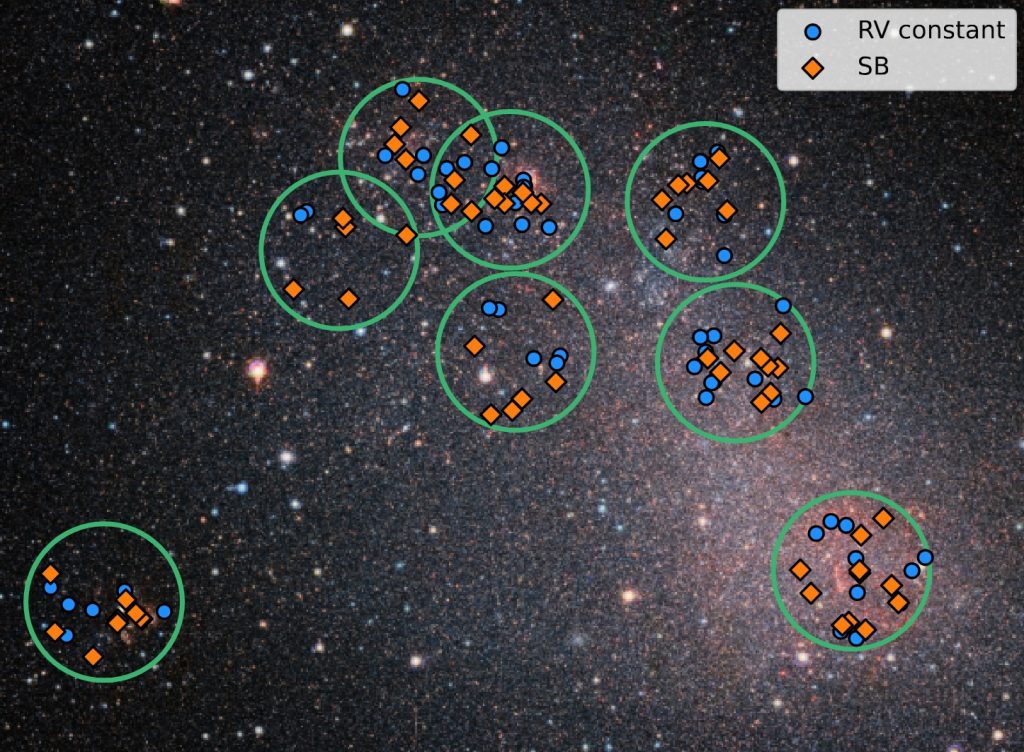Massive stars also partner in metal-poor environments
Massive stars in metal-rich galaxies, such as in our own Milky Way, often have close partners. That this is also true for massive stars in metal-poor galaxies has now been shown by an international team of astronomers who monitored the velocities of massive stars in the Small Magellanic Cloud by using the Very Large Telescope in Chile. The findings have been published in Nature Astronomy.

(c) ESO/Sana et al.
Many massive stars in our metal-rich Milky Way have a partner – a fact that has been known for several decades. The interaction between these partners is important for the evolution and ultimate fate of massive stars. Until recently, however, astronomers were unsure whether massive stars in metal-poor galaxies are also regularly found in binary systems. It now turns out that this is indeed the case.
Traveling back in time: the Small Magellanic Cloud
“We used the Small Magellanic Cloud as a time machine,” explains first author Hugues Sana from KU Leuven (Belgium), because “the Small Magellanic Cloud has a metallicity environment representative of that of distant galaxies when the Universe was only a few billion years old.”
Studying massive stars outside the Milky Way is always challenging because they are far away and we receive relatively little light from them. That is why the team used the FLAMES spectrograph on the Very Large Telescope of the European Southern Observatory in Chile, one of the world’s largest telescopes. FLAMES has 132 fibre optics, each of which can be directed at a different star and then be observed simultaneously.
Accelerating and decelerating: signs for nearby partners
Over a period of three months, the researchers observed the acceleration and deceleration of 139 massive O-type stars at nine different times. These stars with masses between 15 and 60 times that of our Sun are hot, shine brightly, and end their lives in supernova explosions. In the process, the star’s core either collapses into a neutron star or a black hole. The results show that over 70 per cent of the observed stars accelerate and decelerate – a sign of a nearby partner.
“The fact that massive stars in the Small Magellanic Cloud have a partner suggests that the first stars in the universe, which we suspect were also massive, had partners, too,” says Julia Bodensteiner from the University of Amsterdam (The Netherlands), one of the co-authors of the study. “Perhaps some of those systems end up as two black holes orbiting each other. It’s an exciting thought.”
The researchers will now observe the same stars sixteen more times in the near future to reconstruct the precise orbits of the binary stars, determining the masses of their components, and studying the nature and properties of the companion star.
“Using our measurements, cosmologists and astrophysicists studying the young, metal-poor universe will then be able to rely on our knowledge of massive binary stars with greater confidence,” concludes Tomer Shenar of Tel Aviv University (Israel).
The observations for this study were taken within the “Binarity at Low Metallicity” (BLOeM) survey, which is the successor program of a similar observing campaign in the Large Magellanic Cloud, called the VLT-FLAMES Tarantula Survey (VFTS). The VFTS collaboration visited the Heidelberg Institute for Theoretical Studies (HITS) in 2022 for one of their workshops. “We are very excited to further explore this huge treasure trove of new data and look forward to other great discoveries that help us understand massive stars a bit better”, says Fabian Schneider from HITS, one of the authors of the study.
More information
https://www.astronomie.nl/nieuws/en/massive-star-in-metal-poor-environment-often-have-close-partner-4639
This research was presented in Nature Astronomy under the title A high fraction of close massive binary stars at low metallicity. https://www.nature.com/articles/s41550-025-02610-x
About HITS
HITS, the Heidelberg Institute for Theoretical Studies, was established in 2010 by physicist and SAP co-founder Klaus Tschira (1940-2015) and the Klaus Tschira Foundation as a private, non-profit research institute. HITS conducts basic research in the natural, mathematical, and computer sciences. Major research directions include complex simulations across scales, making sense of data, and enabling science via computational research. Application areas range from molecular biology to astrophysics. An essential characteristic of the Institute is interdisciplinarity, implemented in numerous cross-group and cross-disciplinary projects. The base funding of HITS is provided by the Klaus Tschira Foundation.